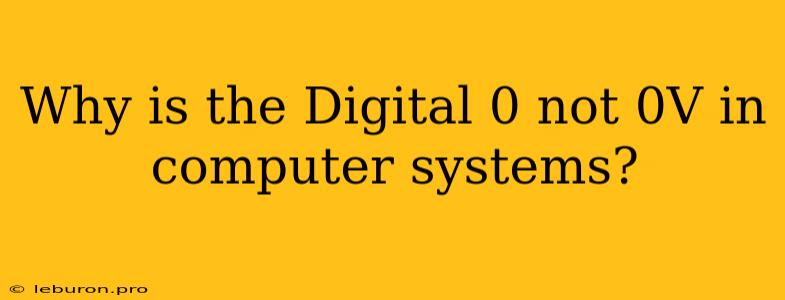In the realm of computer systems, the digital world operates on binary logic, employing two distinct states: 0 and 1. These states are represented by voltage levels, with 0 typically associated with a lower voltage and 1 with a higher voltage. However, a common misconception arises when understanding how these states translate to actual voltage values. While we might intuitively expect a digital 0 to correspond to 0V, this is not the case. This article explores the reasons behind this discrepancy and delves into the significance of the digital 0 not being 0V in computer systems.
Understanding Voltage Levels and Digital Signals
To comprehend why a digital 0 isn't 0V, we need to grasp the fundamental principles of voltage levels and their role in representing digital signals. In essence, a digital signal is a series of electrical pulses that convey information. These pulses are characterized by their voltage levels, which can fluctuate between two distinct thresholds. The specific voltage values used to represent 0 and 1 vary depending on the technology and the particular circuit. However, the key point is that these voltage levels must be sufficiently different to ensure reliable signal interpretation.
Threshold Levels and Signal Interpretation
The transition between digital 0 and 1 occurs at predefined threshold levels. These thresholds are set to distinguish between the two states reliably. For instance, in a particular system, a voltage below 0.8V might be considered a digital 0, while a voltage above 2.4V might be interpreted as a digital 1. Any voltage falling within this range (between 0.8V and 2.4V) would be considered an undefined state, potentially leading to errors in signal interpretation.
The Importance of Noise Margin
Another critical factor that influences the choice of voltage levels is the concept of noise margin. Noise refers to unwanted electrical disturbances that can occur in electronic circuits. Noise margin refers to the difference between the threshold levels and the actual voltage levels representing 0 and 1. This margin acts as a buffer against noise interference, ensuring that even with slight variations in voltage due to noise, the system can still correctly interpret the signals.
Why Digital 0 Can't Be 0V
Now, let's address the key question: why can't a digital 0 be 0V? The answer lies in the limitations imposed by real-world electronics and the need for noise immunity.
1. Practical Considerations:
- Current Leakage: Even in an ideal scenario, there would be a small amount of current leakage in any electronic circuit. This leakage current can cause a slight voltage drop, meaning that even when the circuit is supposed to be at 0V, there might be a small positive voltage present.
- Transistor Characteristics: Transistors, the fundamental building blocks of electronic circuits, have inherent characteristics that dictate their behavior. A transistor can't completely switch off and become a perfect insulator. There's always a small amount of current flowing through it, even when it's supposed to be off. This contributes to the presence of a small voltage even when representing a digital 0.
2. Noise Immunity:
- Noise Reduction: Having a small positive voltage for a digital 0 creates a noise margin. This margin allows for variations in voltage due to noise without misinterpreting the signal.
- Signal Integrity: A larger voltage difference between 0 and 1 enhances signal integrity, making the signal transmission more robust against noise interference.
Implications of Digital 0 Not Being 0V
The fact that a digital 0 is not 0V has significant implications in computer systems:
- Logical Operations: Digital circuits perform logical operations based on the voltage levels representing 0 and 1. The specific voltage levels for 0 and 1 are not relevant as long as they are sufficiently distinct for reliable interpretation.
- Power Consumption: While a digital 0 might not be 0V, it's still a low-power state compared to a digital 1. This is due to the lower current flow associated with a digital 0 voltage.
- Signal Strength: A higher voltage for a digital 1 ensures stronger signal strength, leading to reliable data transmission across various components of a computer system.
Conclusion
The concept of a digital 0 not being 0V is a fundamental aspect of computer systems. This distinction stems from practical considerations related to current leakage, transistor characteristics, and the need for noise immunity. While a digital 0 might not correspond to 0V, the underlying principles of binary logic and the defined threshold levels ensure reliable signal interpretation and robust operation of computer systems. Understanding the implications of this concept is crucial for anyone seeking a deeper understanding of how computer systems function.
